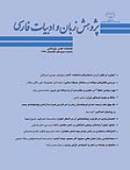اشتراکات ساختاری در شعر نیما و چند شاعر معاصر
محورهای موضوعی : پژوهشهای ادبیات کلاسیک ایرانمحمد خسروی شکیب 1 , قاسم صحرائي 2
1 - دانشگاه لرستان
2 - دانشکده ادبیات و علوم انسانی
کلید واژه: ساختارگرایی شعر معاصر زبان مرکزیتگرایی انتزاعگرایی,
چکیده مقاله :
هر نوعي از انواع متعدد هنر– شعر، داستان کوتاه، رمان، نثر- تحت حمايت سبکي خاص و مستقل، يک نظام نوشتاري تلقي ميشود که مبتني بر مناسبات و انتظارات ساختاری و تنظيمات زباني و به صورت کلي متکي بر پيشينهی نظريههاي ادبي مستقل و خاص خود ميباشد. بديهي است، بداعت يک سبک، مديون استقلال و تازگي تئوريهاي پيشاساختاري است که واقعيت آن سبک را به عنوان جرياني خاص و با قابليت پيروي و تداوم تضمين ميکند. طرح ساختاري مستقل با شيوههاي زباني سنجيده و نو، همراه با جهان نگري بعدپذير، اساساً پيش فرض و حداقل شرطي است که هر سبک جديد و تازهاي براي به دست آوردن استقلال خود نيازمند آن است. شعر معاصر به رهبري نيما و پیروان او سپهری و فروغ، متکي بر مشخصههاي هستي شناسيک و زيباشناسيک است که واقعيت آن را به عنوان يک جريان ريشهدار و با قابليت پيروي و تداوم و از همه مهمتر با استقلال و هويت، نشان ميدهد. در اين مقاله، اشتراکات ساختاری شعر نیما، سپهری و فروغ که ارتقا دهنده و اثبات کننده استقلال و تمايز شعر آنها از سطح شعر کلاسيک است، ارزيابي ميشود. اسطورهشکني ساختار، مرکزيت گرايي در نظام صوری، پايان پذيري خلاق، واقعيت گرايي خلاق، استبدادگريزي معنا، انتزاع گرايي در زبان، شعارگرايي در زبان و تعهدگرايي، از مهمترين نشانههاي اشتراک ساختاری در شعر نیما، سپهری و فروغ است.
Being attributed to an especial and autonomous style, every literary genre – poetry, short story, novel, and prose – is considered as a writing system, that relies on the structural relations and expectations, linguistic arrangements, and in general, its own backgrounds of literary theories. Obviously, any style owes its newness to the autonomy and newness of the pre-structural theories which guarantee its reality as a special stream of the capability to be followed and continued. To offer an autonomous structure with mature and innovative ways of expression and a world-view capable of receiving new dimensions is basically a presupposition and a precondition for every new style to attain its autonomy. Contemporary poetry under the leadership of Nima and his followers – Sepehri and Forouq – relies on the ontological and aesthetic features conveying its reality as a deeply rooted stream of the capability to be followed and continued, and the most important of all, as a stream of autonomy and identity. The present article evaluates the structural sameness of the poetry of Nima, Sepehri and Forouq which distinguishes their poetry from the classical one. Demythologizing of the constructions, centralism in formal systems, innovative endings, innovative realism, avoiding the meaning totalitarianism, abstractionism in language, agitation through language, and commitment to humanity are the evidences of structural sameness of their poetry.


